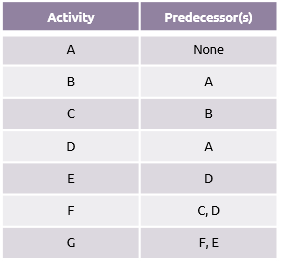In precedence diagrams the basic building block that represents an activity is a box (or node). Activity boxes are linked to show the sequence in which the activities will be performed.
For example:

Prepare meal is the predecessor of eat meal. Conversely, eat meal is the successor of prepare meal.
The table below shows a list of activities followed by their predecessors. The second column shows the activities that have to be finished before the activity in the first column can start.

The resultant network is shown below:

In this example all the links show that when one activity is finished another can start. This is known as a finish to start link.
Three more ways to indicate the relationship between a pair of activities are:
- Start-to-start:
-
In this relationship, B can start once A has started. In situations like this it is unlikely that the two would start simultaneously and there is likely to be a lead time between A starting and B starting. The period between the two starts can be placed on the link and included in critical path analysis.
- Finish-to-finish:
-
In this relationship, B can finish once A has finished. If there is a minimum time necessary between A finishing and B finishing this can be placed on the link and included in the critical path calculation that is described in the next section.
- Start-to-finish:
-
It is unusual to find a situation that uses this type of link. It indicates that B cannot finish until A has started. Just like start-to-start and finish-to-finish dependencies, a time period can be allocated to the link to show a minimum amount of time that must elapse between the two points.
If activities can run in parallel they may be shown with a combination of start-to-start and finish-to-finish links. Sequences of activities linked in this way are known as ladders.





